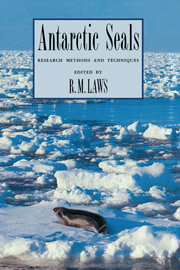Book contents
- Frontmatter
- Contents
- List of contributors
- Preface
- Introduction
- 1 Identification of species
- 2 Estimation of population sizes
- 3 Immobilization and capture
- 4 Marking techniques
- 5 Telemetry and electronic technology
- 6 Behaviour
- 7 Killing methods
- 8 Morphometrics, specimen collection and preservation
- 9 Genetic-based studies for stock separation
- 10 Collection of material for the determination of organochlorine and heavy metal levels
- 11 Age determination
- 12 Reproduction
- 13 Diet
- 14 Bioenergetics
- 15 Development of technology and research needs
- 16 Appendices
- Index
6 - Behaviour
Published online by Cambridge University Press: 05 February 2010
- Frontmatter
- Contents
- List of contributors
- Preface
- Introduction
- 1 Identification of species
- 2 Estimation of population sizes
- 3 Immobilization and capture
- 4 Marking techniques
- 5 Telemetry and electronic technology
- 6 Behaviour
- 7 Killing methods
- 8 Morphometrics, specimen collection and preservation
- 9 Genetic-based studies for stock separation
- 10 Collection of material for the determination of organochlorine and heavy metal levels
- 11 Age determination
- 12 Reproduction
- 13 Diet
- 14 Bioenergetics
- 15 Development of technology and research needs
- 16 Appendices
- Index
Summary
Introduction
On a superficial level most seal behaviour seems straightforward, but recording behavioural observations for scientific use can be deceptively difficult. The object of this chapter is to provide some guidelines on the kinds of data that are important, and the methods that can be used. Of necessity, this discussion is orientated towards recording the terrestrial behaviour of seals; recording behaviour at sea requires special instrumentation and is discussed in chapter 5. Renouf (1991) provides a detailed review of pinniped behaviour.
We will begin by describing briefly how to quantify behaviour and then discuss in more detail some of the categories of behavioural observation that are applicable to population ecology, the biology of species, and to defining taxonomic affinities. For each category the types of observations to be made are described, along with the species or situations to which they apply. Specific applications of behavioural knowledge are discussed, and references for further study are given.
Background information
Behavioural questions
Whenever possible, we recommend that overall objectives and specific behavioural questions be posed before the study begins. It is especially true of behavioural studies, that researchers are tempted to collect data in the field and then distil the questions from the mass of data accumulated. For those going to Antarctica or the sub-Ant arctic islands specifically to study seals the questions should be based on extensive prior reading about the behaviour of the target species and of related species. These questions may be posed as hypotheses that can be tested by the results of field research.
- Type
- Chapter
- Information
- Antarctic SealsResearch Methods and Techniques, pp. 140 - 154Publisher: Cambridge University PressPrint publication year: 1993
- 1
- Cited by



